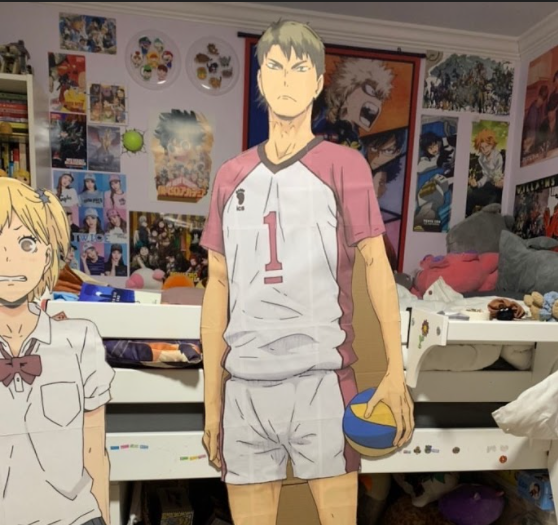The stories behind a fascination with anime
Exploring the appeal of anime for foreign audiences

Junior Kayla Leung shows off her anime merchandise filled room.
September 13, 2020
Quickly drawn into the world of Japanese anime and entranced by the animation and complex storylines, junior Kayla Leung has been a fan of anime ever since she had seen fans post about shows online. Through memes, cosplays of characters and other show related content, Leung has changed her opinion of anime from being “nothing special” to becoming an avid watcher.
“I like anime because it has the ability to exaggerate things that would just look ridiculous in live-action [shows],” Leung said. “The way [animators] present the characters and over-exaggerate the features or emotions can only be done through animation. And the plotlines are really, really absurd.”
Leung is just one of the many people who have been hooked into an industry that now brings around 19 billion dollars per year. And according to The Association of Japanese Animations, the worldwide popularity of anime has been steadily increasing since 2012.
Junior Collin Ong’s first anime encounter was with “Pokémon.” Since its creation in 1995, Pokemon has continued to attract many fans, making it the highest-grossing franchise of all time, with $90 billion in total revenue.
“I just find anime overall more interesting than American shows like ‘The Office’ or ‘Friends,’ stuff like that,” Ong said. “‘[Pokemon]’ is just what I grew up watching and also it was used as an escape for me because in first grade I was bullied a lot.”

Since Ong’s introduction to anime in kindergarten, it continues to be a large part of his life today. Ong currently takes Japanese at school, has started a “YuGiOh” –– a card game and anime –– club during his time at Kennedy MS and is currently a member of Anime Club at MVHS.
Similarly, President of Anime Club, senior Charlie Jyu, began watching anime when he was much younger, in sixth grade. After joining the very small club during his freshman year, Jyu has assumed officer positions in the following years and aims to expand the club as the current president.
“When I joined in my freshman year, the anime club was actually really small,” Jyu said. “I had never heard of it before, and a lot of students had never heard of it. This year I’m continuing as president, trying to make the club better [and] more popular and invite as many people as possible.”
Although Jyu’s aim is to introduce more students to anime, he notes that they are not the only people it is meant for. Leung agrees, even though the majority of anime’s audience is made up of teenagers, that anime is made for all generations. It encompasses a variety of genres, as opposed to American cartoons that she finds are targeted at children and have shallow plotlines.
“[Anime is] more intriguing rather than just animals with faces and weird accents talking and screwing around,” Leung said. “It covers heavier topics, like [the movie] Grave of the Fireflies, which covers a story about two children that lost their mother in World War Two and then have to survive on their own.”
[Anime is] more intriguing rather than just animals with faces and weird accents talking and screwing around. It covers heavier topics, like [the movie] Grave of the Fireflies, which covers a story about two children that lost their mother in World War Two and then have to survive on their own.
— Kayla Leung
From Ong’s perspective, people who don’t watch anime may have negative views about it due to their limited knowledge of what it really entails. Just like Western TV, anime has many genres, ranging from sports to family friendly or mature themes. Both Ong and Leung feel that anime attracts a large following because of its versatility, and because there is so much variety in anime, people can find niches they relate to. Anime is more than just a source of entertainment for Leung, and it has led to her being able to talk to more people.
“I’ve definitely bonded [with other people] through a common interest in anime because there’s this deeper level of storytelling for the characters that you can only get through animation, and you can’t reach through actual actors,” Leung said. “There’s something about the characters that makes them so much more easy to like compared to real-life actors. You kind of form a bond with the characters.”
















